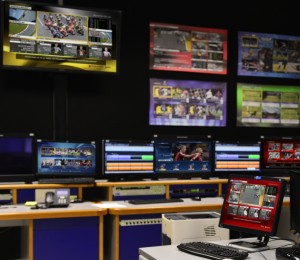deltatre discusses VR, AR, MR and the evolution of sports storytelling
One of the most exciting developments in sports broadcasting at present concerns the development of virtual reality, augmented reality, mixed reality and the impact of these various technologies on storytelling. deltatre is one of the leading lights of this rapidly evolving area of technology, and in a new interview with SVG Europe, the company’s commercial director (international markets), Andrea Marini, provided some thoughts on the present and future of these innovations.
Andrea Marini comments: “The centre of the content is always ‘just a a story’ that has to be interesting; without this the rest does not make sense. You have to create a context, it is important and significant, and the story can be carried anywhere, thanks to the connectivity that must serve on all platforms and is indispensable.”
deltatre creates stories with and for its customers on a variety of different platforms, and is working with both 4K and 8K graphics. Just think of the typical fan who wants to see what happened the night before in a match; he does not want to see a video, and certainly not only the final results as straightforward numbers on the web. Instead, he can now enjoy a true interaction between the presenter and the augmented reality environment featuring a dynamic graphic representation.
Marini continues: “The story is no longer told in B2C style, but B2B style. The contents are now very appealing, cutting edge and ‘productized’; [in other words] tailored precisely according to the television product that you want to offer. So any sports story is scaled and ‘deliverable’, ie. it is finally [possible to easily] reach the predetermined receivers [and] ‘targeted’ viewers.”
New stories to tell
The ability to tell stories in new and different ways is proving useful to broadcasters and publishers looking to put together a variety of content packages. By way of an example Marini cites the post-match period “where some players may appear on the left of the screen as the announcer on the right tells the stories in augmented reality-style on the field, for excellent video interaction of live and synthetic 3D images. Other interesting moments include new creativity [that is] rather close to ‘gaming’ when players enter the stadium…”
“The main driver for this [evolution] is that we can give the user exactly what he/she wants in a personalised way; the user becomes their own programme director or producer. That means they can choose the cameras, the [domestic] feed, global live feed [and so on, in order] to compose a personal vision at all times.
“In football, for example, he may choose to follow the goals, substitutions or bad fouls. In fact all the cameras in the field are available for the viewer and in the cloud only 4/5 minutes after the action, allowing the user to open up a digital map and select what they wish to see inside the stadium. This enables them to capture fine details that in the live feed may be lost [because the director is obliged to frame the playing area].”
The new ways of storytelling now emerging in sports make it possible to construct fresh and exciting narratives – opening up new creative pathways for broadcasters as well as further opportunities for monetisation.

